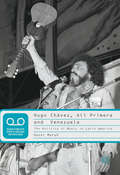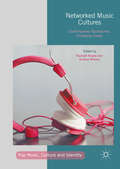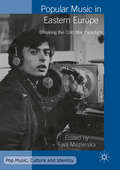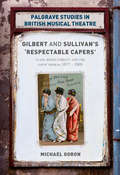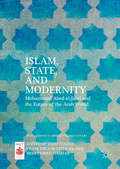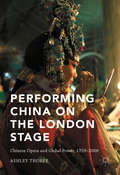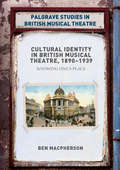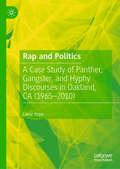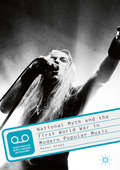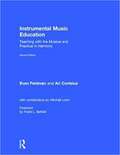- Table View
- List View
Hugo Chávez, Alí Primera and Venezuela
by Hazel MarshUnlike much of the literature on Venezuela in the Ch#65533;vez period, this book shifts focus away from 'top down' perspectives to examine how Venezuelan folksinger Al#65533; Primera (1942-1985) became intertwined with Venezuelan politics, both during his lifetime and posthumously. Al#65533;'s 'Necessary Songs' offered cultural resources that enabled Ch#65533;vez to connect with pre-existing patterns of grassroots activism in ways that resonated deeply with the poor and marginalised masses. Official support for Al#65533;'s legacy led the songs to be used in new ways in the Ch#65533;vez period, as Venezuelans actively engaged with them to redefine themselves in relation to the state and to reach new understandings of their place within a changed society. This book is essential reading not only for those interested in popular music and politics, but for all those seeking to better understand how Ch#65533;vez was able to successfully identify himself so profoundly with the Venezuelan masses, and they with him.
Networked Music Cultures
by Raphaël Nowak Andrew WhelanThis collection presents a range of essays on contemporary music distribution and consumption patterns and practices. The contributors to the collection use a variety of theoretical and methodological approaches, discussing the consequences and effects of the digital distribution of music as it is manifested in specific cultural contexts. The widespread circulation of music in digital form has far-reaching consequences: not least for how we understand the practices of sourcing and consuming music, the political economy of the music industries, and the relationships between format and aesthetics. Through close empirical engagement with a variety of contexts and analytical frames, the contributors to this collection demonstrate that the changes associated with networked music are always situationally specific, sometimes contentious, and often unexpected in their implications. With chapters covering topics such as the business models of streaming audio, policy and professional discourses around the changing digital music market, the creative affordances of format and circulation, and local practices of accessing and engaging with music in a range of distinct cultural contexts, the book presents an overview of the themes, topics and approaches found in current social and cultural research on the relations between music and digital technology.
Popular Music in Eastern Europe
by Ewa MazierskaThis book explores popular music in Eastern Europe during the period of state socialism, in countries such as Poland, Hungary, Yugoslavia, Romania, Czechoslovakia, the GDR, Estonia and Albania. It discusses the policy concerning music, the greatest Eastern European stars, such as Karel Gott, Czesław Niemen and Omega, as well as DJs and the music press. By conducting original research, including interviews and examining archival material, the authors take issue with certain assumptions prevailing in the existing studies on popular music in Eastern Europe, namely that it was largely based on imitation of western music and that this music had a distinctly anti-communist flavour. Instead, they argue that self-colonisation was accompanied with creating an original idiom, and that the state not only fought the artists, but also supported them. The collection also draws attention to the foreign successes of Eastern European stars, both within the socialist bloc and outside of it. v>
Gilbert and Sullivan's 'Respectable Capers'
by Michael GoronThis innovative account of the Gilbert and Sullivan partnership provides a unique insight into the experience of both attending and performing in the original productions of the most influential and enduring pieces of English-language musical theatre. In the 1870s, Savoy impresario Richard D'Oyly Carte astutely realized that a conscious move to respectability in a West End which, until then, had favored the racy delights of burlesque and French operetta, would attract a new, lucrative morally 'decent' audience. This book examines the commercial, material and human factors underlying the Victorian productions of the Savoy operas. Unusually for a book on 'G&S', it focuses on people and things rather than author biography or literary criticism. Examining theatre architecture, interior design, marketing, and typical audiences, as well as the working conditions and personal lives of the members of a Victorian theatre-company, 'Respectable Capers' explains how the Gilbert and Sullivan operas helped to transform the West End into the family-friendly 'theatre land' which still exists today.
Islam, State, and Modernity
by Zaid Eyadat Francesca M. Corrao Mohammed HashasThis book offers the first comprehensive introduction to one of the most significant Arab thinkers of the late 20th century and the early 21st century: the Moroccan philosopher and social theorist Mohammed Abed al-Jabri. With his intellectual and political engagement, al-Jabri has influenced the development of a modern reading of the Islamic tradition in the broad Arab-Islamic world and has been, in recent years, subject to an increasing interest among Muslims and non-Muslim scholars, social activists and lay men. The contributors to this volume read al-Jabri with reference to prominent past Arab-Muslim scholars, such as Ibn Rushd, al-Ghazali, al-Shatibi, and Ibn Khaldun, as well as contemporary Arab philosophers, like Hassan Hanafi, Abdellah Laroui, George Tarabishi, Taha Abderrahmane; they engage with various aspects of his intellectual project, and trace his influence in non-Arab-Islamic lands, like Indonesia, as well. His analysis of Arab thought since the 1970s as a harbinger analysis of the ongoing "Arab Spring uprising" remains relevant for today's political challenges in the region.
Performing China on the London Stage
by Ashley ThorpeThis book details the history of Chinese theatre, and British representations of Chinese theatre, on the London stage over a 250-year period. A wide range of performance case studies - from exhibitions and British Chinese opera inspired theatre, to translations of Chinese plays and visiting troupes - highlight the evolving nature of Sino-British trade, fashion, migration, the formation of diaspora, and international relations. Collectively, they outline the complex relationship between Britain and China - the rise and fall of the British Empire, and the fall and rise of China - as it was played out on the stages of London across three centuries. Drawing extensively upon archival materials and fieldwork research, the book offers new insights for intercultural British theatre in the 21st century - 'the Asian century'.
Cultural Identity in British Musical Theatre, 1890–1939: Knowing One's Place (Palgrave Studies In British Musical Theatre Ser.)
by Ben MacphersonThis book examines the performance of ‘Britishness’ on the musical stage. Covering a tumultuous period in British history, it offers a fresh look at the vitality and centrality of the musical stage, as a global phenomenon in late-Victorian popular culture and beyond. Through a re-examination of over fifty archival play-scripts, the book comprises seven interconnected stories told in two parts. Part One focuses on domestic and personal identities of ‘Britishness’, and how implicit anxieties and contradictions of nationhood, class and gender were staged as part of the popular cultural condition. Broadening in scope, Part Two offers a revisionary reading of Empire and Otherness on the musical stage, and concludes with a consideration of the Great War and the interwar period, as musical theatre performed a nostalgia for a particular kind of ‘Britishness’, reflecting the anxieties of a nation in decline.
Rap and Politics: A Case Study of Panther, Gangster, and Hyphy Discourses in Oakland, CA (1965-2010)
by Lavar PopeRap and Politics maps out fifty years of political and musical development by exploring three specific moments of local discourse, each a response to failures by local, state, and national governments to address police brutality, violence, poverty, and poor social conditions in Oakland, California and the surrounding Bay Area. First, in the mid-1960s, Black youth responded to repressive political and socioeconomic factors in West Oakland by founding the Black Panther Party for Self Defense, whose representation of violence and community aid, as well as its radical and militant approach to Black Nationalism, became a foundational discourse that shaped the development of rap music in the region. Second, from the collapse of the Party in the early 1980s through the 1990s, gangster rap emerged as a form of political expression among local youth, who drew heavily on radical and militant elements of Panther discourse in their lyrics and artwork. Third, hyphy music in the mid-1990s to early 2000s continued these radical discourses and also incorporated coordinated, subversive public behavior to the mix. The result was a critique of endemic problems facing the local Black community, but also an infectious subgenre of party music that gained mainstream popularity. Overall, this study shows that the specific types of representation created to resist problems of racism and poverty in Oakland is actually key to understanding other rap undergrounds, grassroots subcultures, and social movements elsewhere. In the process, Rap and Politics offers readers a new model focused on the development of settings, representation, movements, discourse banks, and impact within underground rap scenes.
National Myth and the First World War in Modern Popular Music
by Peter GrantThis book looks at the role of popular music in constructing the myth of the First World War. Since the late 1950s over 1,500 popular songs from more than forty countries have been recorded that draw inspiration from the War. National Myth and the First World War in Modern Popular Music takes an inter-disciplinary approach that locates popular music within the framework of 'memory studies' and analyses how songwriters are influenced by their country's 'national myths'. How does popular music help form memory and remembrance of such an event? Why do some songwriters stick rigidly to culturally dominant forms of memory whereas others seek an oppositional or transnational perspective? The huge range of musical examples include the great chansonniers Jacques Brel and Georges Brassens; folk maestros including Al Stewart and Eric Bog≤ the socially aware rock of The Kinks and Pink Floyd; metal legends Iron Maiden and Bolt Thrower and female iconoclasts Diamanda Gal#65533;s and PJ Harvey.
Instrumental Music Education: Teaching with the Musical and Practical in Harmony
by Evan Feldman Ari Contzius<p>Instrumental Music Education: Teaching with the Musical and Practical in Harmony, 2nd Edition is intended for college instrumental music education majors studying to be band and orchestra directors at the elementary, middle school, and high school levels. This textbook presents a research-based look at the topics vital to running a successful instrumental music program, while balancing musical, theoretical, and practical approaches. A central theme is the compelling parallel between language and music, including "sound-to-symbol" pedagogies. Understanding this connection improves the teaching of melody, rhythm, composition, and improvisation. <p>The companion website contains over 120 pedagogy videos for wind, string, and percussion instruments, performed by professional players and teachers, over 50 rehearsal videos, rhythm flashcards, and two additional chapters, "The Rehearsal Toolkit," and "Job Search and Interview." It also includes over 50 tracks of acoustically pure drones and demonstration exercises for use in rehearsals, sectionals and lessons.</p>
Metaphors of Depth in German Musical Thought
by Holly WatkinsWhat does it mean to say that music is deeply moving? Or that music's aesthetic value derives from its deep structure? This study traces the widely employed trope of musical depth to its origins in German-language music criticism and analysis. From the Romantic aesthetics of E. T. A. Hoffmann to the modernist theories of Arnold Schoenberg, metaphors of depth attest to the cross-pollination of music with discourses ranging from theology, geology and poetics to psychology, philosophy and economics. The book demonstrates that the persistence of depth metaphors in musicology and music theory today is an outgrowth of their essential role in articulating and transmitting Germanic cultural values. While musical depth metaphors have historically served to communicate German nationalist sentiments, Watkins shows that an appreciation for the broad connotations of those metaphors opens up exciting new avenues for interpretation.
Histories of Heinrich SchüTz
by Bettina VarwigBettina Varwig places the music of the celebrated Dresden composer Heinrich Schütz in a richly detailed tapestry of cultural, political, religious and intellectual contexts. Four key events in Schütz's career – the 1617 Reformation centenary, the performance of his Dafne in 1627, the 1636 funeral composition Musikalische Exequien and the publication of his motet collection Geistliche Chormusik (1648) – are used to explore his music's resonances with broader historical themes, including the effects of the Thirty Years' War, contemporary meanings of classical mythology, Lutheran attitudes to death and the afterlife as well as shifting conceptions of time and history in light of early modern scientific advances. These original seventeenth-century circumstances are treated in counterpoint with Schütz's fascinating later reinvention in nineteenth- and twentieth-century German musical culture, providing a new kind of musicological writing that interweaves layers of historical inquiry from the seventeenth century to the present day.
Mendelssohn, Time and Memory
by Benedict TaylorFelix Mendelssohn has long been viewed as one of the most historically minded composers in western music. This book explores the conceptions of time, memory and history found in his instrumental compositions, presenting an intriguing new perspective on his ever-popular music. Focusing on Mendelssohn's innovative development of cyclic form, Taylor investigates how the composer was influenced by the aesthetic and philosophical movements of the period. This is of key importance not only for reconsideration of Mendelssohn's work and its position in nineteenth-century culture, but also more generally concerning the relationship between music, time and subjectivity. One of very few detailed accounts of Mendelssohn's music, the study presents a new and provocative reading of the meaning of the composer's work by connecting it to wider cultural and philosophical ideas.
Performing Operas for Mozart
by Ian WoodfieldThe Italian opera company in Prague managed by Pasquale Bondini and Domenico Guardasoni played a central role in promoting Mozart's operas during the final years of his life. Using a wide range of primary sources which include the superb collections of eighteenth-century opera posters and concert programmes in Leipzig and the Indice de' teatrali spettacoli, an almanac of Italian singers and dancers, this study examines the annual schedules, recruitment networks, casting policies and repertoire selections of this important company. Woodfield shows how Italian-language performances of Figaro, Don Giovanni, Cosi fan tutte and La clemenza di Tito flourished along the well-known cultural axis linking Prague in Bohemia to Dresden and Leipzig in Saxony. The important part played by concert performances of operatic arias in the early reception of Mozart's works is also discussed and new information is presented about the reception of Josepha Duschek and Mozart in Leipzig.
Ancient Greek Music
by Stefan HagelThis 2009 book endeavours to pinpoint the relations between musical, and especially instrumental, practice and the evolving conceptions of pitch systems. It traces the development of ancient melodic notation from reconstructed origins, through various adaptations necessitated by changing musical styles and newly invented instruments, to its final canonical form. It thus emerges how closely ancient harmonic theory depended on the culturally dominant instruments, the lyre and the aulos. These threads are followed down to late antiquity, when details recorded by Ptolemy permit an exceptionally clear view. Dr Hagel discusses the textual and pictorial evidence, introducing mathematical approaches wherever feasible, but also contributes to the interpretation of instruments in the archaeological record and occasionally is able to outline the general features of instruments not directly attested. The book will be indispensable to all those interested in Greek music, technology and performance culture and the general history of musicology.
Choral Fantasies
by Ryan MinorMost histories of nineteenth-century music portray 'the people' merely as an audience, a passive spectator to the music performed around it. Yet, in this reappraisal of choral singing and public culture, Minor shows how a burgeoning German bourgeoisie sang of its own collective aspirations, mediated through the voice of celebrity composers. As both performer and idealized community, the chorus embodied the possibilities and limitations of a participatory, national identity. Starting with the many public festivals at which the chorus was a featured participant, Minor's account of the music written for these occasions breaks new ground not only by taking seriously these often-neglected works, but also by showing how the contested ideals of German nationhood suffused the music itself. In situating both music and festive culture within the milieu of German bourgeois liberals, this study uncovers new connections between music and politics during a century that sought to redefine both spheres.
The Quilting Points of Musical Modernism: Revolution, Reaction, and William Walton
by J. P. E. Harper-ScottModernism is both a contested aesthetic category and a powerful political statement. Modernist music was condemned as degenerate by the Nazis and forcibly replaced by socialist realism under the Soviets. Sympathetic philosophers and critics have interpreted it as a vital intellectual defence against totalitarianism, yet some American critics consider it elitist, undemocratic and even unnatural. Drawing extensively on the philosophy of Heidegger and Badiou, The Quilting Points of Musical Modernism proposes a new dialectical theory of faithful, reactive and obscure subjective responses to musical modernism, which embraces all the music of Western modernity. This systematic definition of musical modernism introduces readers to theory by Badiou, Žižek and Agamben. Basing his analyses on the music of William Walton, Harper-Scott explores connections between the revolutionary politics of the nineteenth and twentieth centuries and responses to the event of modernism in order to challenge accepted narratives of music history in the twentieth century.
Political Beethoven
by Nicholas MathewMusicians, music lovers and music critics have typically considered Beethoven's overtly political music as an aberration; at best, it is merely notorious, at worst, it is denigrated and ignored. In Political Beethoven Nicholas Mathew returns to the musical and social contexts of the composer's political music throughout his career – from the early marches and anti-French war songs of the 1790s to the grand orchestral and choral works for the Congress of Vienna – to argue that this marginalized functional art has much to teach us about the lofty Beethovenian sounds that came to define serious music in the nineteenth century. Beethoven's much-maligned political compositions, Mathew shows, lead us into the intricate political and aesthetic contexts that shaped all of his oeuvre, thus revealing the stylistic, ideological and psycho-social mechanisms that gave Beethoven's music such a powerful voice – a voice susceptible to repeated political appropriation, even to the present day.
The Politics of Opera in Handel's Britain
by Thomas McgearyThe Politics of Opera in Handel's Britain examines the involvement of Italian opera in British partisan politics in the first half of the eighteenth century, which saw Sir Robert Walpole's rise to power and George Frideric Handel's greatest period of opera production. McGeary argues that the conventional way of applying Italian opera to contemporary political events and persons by means of allegory and allusion in individual operas is mistaken; nor did partisan politics intrude into the management of the Royal Academy of Music and the Opera of the Nobility. This book shows instead how Senesino, Faustina, Cuzzoni and events at the Haymarket Theatre were used in political allegories in satirical essays directed against the Walpole ministry. Since most operas were based on ancient historical events, the librettos – like traditional histories – could be sources of examples of vice, virtue, and political precepts and wisdom that could be applied to contemporary politics.
The Accessibility of Music
by Jochen EisentrautQuestions of musical accessibility are relevant to most musical contexts but what does this term mean, how do we make contact with music and how do we decide what music to listen to? In The Accessibility of Music Jochen Eisentraut argues that musical judgements are often based upon implicit attitudes to accessibility, which need to be identified and exposed. Surveying a range of disciplines, including sociology, psychology, aesthetics and cultural theory, Eisentraut investigates how and why music becomes accessible and the impact of accessibility on musical and social hierarchies. The book is structured around three major case studies: punk vs progressive rock, Vaughan Williams and his ideas on art and folk music, and Brazilian samba, both in situ and in a global context. These are used to reveal aspects of musical accessibility at work and serve as a springboard for discussions that challenge accepted ideas of musical value and meaning.
The Orchestral Revolution
by Emily I. DolanThe Orchestral Revolution explores the changing listening culture of the eighteenth and early nineteenth centuries. Delving into Enlightenment philosophy, the nature of instruments, compositional practices and reception history, this book describes the birth of a new form of attention to sonority and uncovers the intimate relationship between the development of modern musical aesthetics and the emergence of orchestration. By focusing upon Joseph Haydn's innovative strategies of orchestration and tracing their reception and influence, Emily Dolan shows that the consolidation of the modern orchestra radically altered how people listened to and thought about the expressive capacity of instruments. The orchestra transformed from a mere gathering of instruments into an ideal community full of diverse, nuanced and expressive characters. In addressing this key moment in the history of music, Dolan demonstrates the importance of the materiality of sound in the formation of the modern musical artwork.
Music: A Mathematical Offering
by Dave BensonSince the time of the Ancient Greeks, much has been written about the relation between mathematics and music: from harmony and number theory, to musical patterns and group theory. Benson provides a wealth of information here to enable the teacher, the student, or the interested amateur to understand at varying levels of technicality, the real interplay between these two ancient disciplines. The story is long as well as broad and involves physics, biology, psycho acoustics, the history of science, and digital technology as well as, of course, mathematics and music. Starting with the structure of the human ear and its relationship with Fourier analysis the story proceeds via the mathematics of musical instruments to the ideas of consonance and dissonance, and then to scales and temperaments. This is a must-have book if you want to know about the music of the spheres or digital music and many things in between.
Opera in the Age of Rousseau
by David CharltonHistorians of French politics, art, philosophy and literature have long known the tensions and fascinations of Louis XV's reign, the 1750s in particular. David Charlton's study comprehensively re-examines this period, from Rameau to Gluck and elucidates the long-term issues surrounding opera. Taking Rousseau's Le Devin du Village as one narrative centrepiece, Charlton investigates this opera's origins and influences in the 1740s and goes on to use past and present research to create a new structural model that explains the elements of reform in Gluck's tragédies for Paris. Charlton's book opens many new perspectives on the musical practices and politics of the period, including the Querelle des Bouffons. It gives the first detailed account of intermezzi and opere buffe performed by Eustachio Bambini's troupe at the Paris Opéra from August 1752 to February 1754 and discusses Rameau's comedies Platée and Les Paladins and their origins.
Harrison Birtwistle's Operas and Music Theatre
by David BeardDavid Beard presents the first definitive survey of Harrison Birtwistle's music for the opera house and theatre, from his smaller-scale works, such as Down by the Greenwood Side and Bow Down, to the full-length operas, such as Punch and Judy, The Mask of Orpheus and Gawain. Blending source study with both music analysis and cultural criticism, the book focuses on the sometimes tense but always revealing relationship between abstract musical processes and the practical demands of narrative drama, while touching on theories of parody, narrative, pastoral, film, the body and community. Each stage work is considered in terms of its own specific musico-dramatic themes, revealing how compositional scheme and dramatic conception are intertwined from the earliest stages of a project's genesis. The study draws on a substantial body of previously undocumented primary sources and goes beyond previous studies of the composer's output to include works unveiled from 2000 onwards.
The Cambridge Companion to the Violin
by Robin StowellThe Cambridge Companion to the Violin offers students, performers, and scholars a fascinating and composite survey of the history and repertory of the instrument from its origins to the present day. The volume comprises fifteen essays, written by a team of specialists, and is intended to develop the violin's historical perspective in breadth and from every relevant angle. The principal subjects discussed include the instrument's structure and development; its fundamental acoustical properties; principal exponents; technique and teaching principles; solo and ensemble repertory; pedagogical literature; traditions in folk music and jazz; and aspects of historical performing practice. The text is supported by numerous illustrations and diagrams as well as music examples, a useful appendix, glossary of technical terms, and an extensive bibliography.
